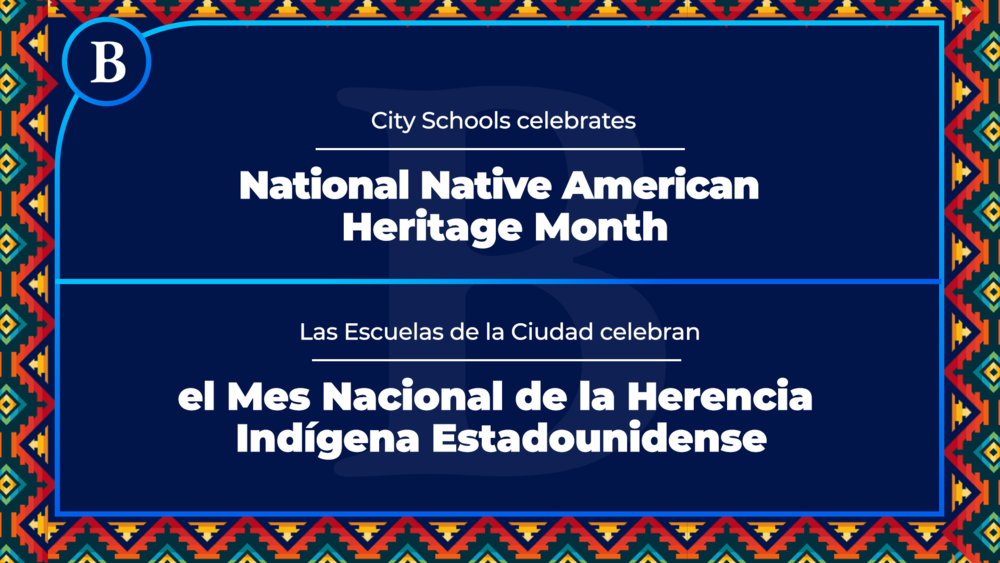City Schools celebrates National Native American Heritage Month, a time dedicated to honoring the rich history, culture, and enduring contributions of the first Americans. This month presents an opportunity to reflect on the vital role Native peoples have played in shaping our country and to acknowledge their enduring impact on communities nationwide.
 National Native American Heritage Month has its roots in early 20th-century efforts to recognize the contributions and histories of Indigenous peoples. In 1915, Dr. Arthur C. Parker, a Cattaraugus Seneca author and historian, first proposed a day to honor Native Americans, which led to sporadic local and state observances. Dr. Parker later advocated for American Indians to receive U.S. citizenship through the National Congress of American Indians in 1944. He also persuaded the Boy Scouts of America to set aside a day for the “First Americans,” which was observed from 1912 to 1915.
National Native American Heritage Month has its roots in early 20th-century efforts to recognize the contributions and histories of Indigenous peoples. In 1915, Dr. Arthur C. Parker, a Cattaraugus Seneca author and historian, first proposed a day to honor Native Americans, which led to sporadic local and state observances. Dr. Parker later advocated for American Indians to receive U.S. citizenship through the National Congress of American Indians in 1944. He also persuaded the Boy Scouts of America to set aside a day for the “First Americans,” which was observed from 1912 to 1915.
In 1976, during the United States Bicentennial, Congress passed a resolution authorizing President Gerald Ford to proclaim a week in October as “Native American Awareness Week.” On October 8, 1976, he issued the presidential proclamation. Since that time, Congress and the President have annually recognized a day, a week, or a month in honor of American Indian and Alaska Native peoples.
While these proclamations did not establish a national theme, they allowed federal departments and agencies to develop their own programs and celebrations highlighting Native American heritage.
In 1990, President George H.W. Bush officially designated November as National American Indian Heritage Month, providing a national platform to celebrate the culture, traditions, and achievements of Native Americans. In 2008 the commemorative language was amended to also include the contributions of Alaskan Natives.

Read more about Native American Heritage Month:
U.S. Department of the Interior Indian Affairs


Elementary
We Are Grateful: Otsaliheliga – Traci Sorell (Ages 4–8)
Jingle Dancer By Cynthia Leitich Smith (ages 4-8)
Berry Song - Michaela Goade (ages 4-8)
The Very First Americans – Cara Ashrose (Ages 5–8)
We are the Water Protectors – Carole Lindstrom (Ages 4–8)

Middle
Indian No More – Charlene Willing McManis & Traci Sorell (Ages 9–12)
Two Roads – Joseph Bruchac (Ages 10–14)
Code Talker – Joseph Bruchac (Ages 12–16)
Ancestor Approved: Intertribal Stories for Kids – Cynthia Leitich Smith (ed.) (Ages 8–12)

High
Firekeeper’s Daughter – Angeline Boulley (Ages 14–18)
There There – Tommy Orange (Ages 15–18)
Hearts Unbroken – Cynthia Leitich Smith (Ages 13–18)
Elatsoe – Darcie Little Badger (Ages 12–18)
Apple: Skin to the Core – Eric Gansworth (Ages 12–18)

Many Baltimore streets reflect Native American heritage, such as Patapsco Avenue—named after the Patapsco River, whose name comes from a Native American word meaning “backwater” or “tide covered with froth.”
Is your school or student celebrating Native American Heritage Month? Share the story and photos with us through our City Schools Good News form.
Created by City Schools with assistance from AI.

